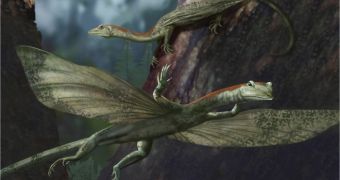Flying dragons were on fashion even before the advent of the dinosaurs.
Paleontologists have just described a unique type of a new long-necked, gliding reptile found in 220 million-year old (Triassic era) sediments of eastern North America, in a time when dinosaurs were in the cradle.
Mecistotrachelos apeoros (meaning "soaring, long-necked") which has been described is based on two fossils excavated at the Solite Quarry that straddles the Virginia-North Carolina state line.
"One of the really neat things about the new glider is the feet. They are preserved in a hooked posture which is unusual and strongly suggests a grasping habit, further emphasizing a life style in the trees." said Nick Fraser of the Virginia Museum of Natural History, who discovered the fossils.
The ancient reptile was probably insectivorous, scuttling up tree trunks and foraging on the way, before gliding onto neighboring trees.
"While two other reptiles with similar gliding membranes are known from the Triassic Period, they have much shorter necks and therefore conform more to the modern gliding lizard, Draco." said Fraser.
The kinship of Mecistotrachelos is not solved yet, but Fraser tends to relate it to the protorosaurs (thus, more related to crocodiles and dinosaurs than to lizards).
Protorosaurs are a group of ancient reptiles characterized by a long neck, like the bizarre Tanystropheus which had a neck longer than the length of the body and tail combined and most of them were arboreal.
Due to the type of the sediments, the fossils could not be investigated by standard mechanical methods and the descriptions are based entirely on CT scans, a rare approach to describe new species.
"This is a really cool little reptile which was very difficult to see until we looked at the CT scans", said Tim Ryan of the Center for Quantitative Imaging at Pennsylvania State University, who led the work on the CT scanning.

 14 DAY TRIAL //
14 DAY TRIAL //